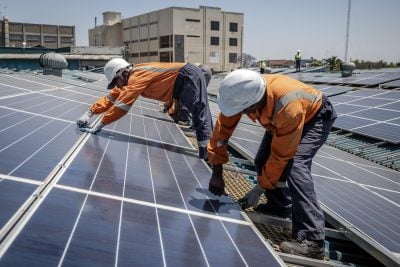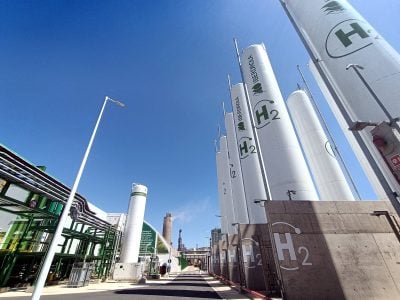Neil Ford reports on national and regional energy transition strategies in Southern Africa
The power strategies of many Southern African states are heavily influenced by the trials and tribulations of South Africa’s state-owned power utility, Eskom, because of its role in supplying electricity to the Southern African Power Pool (SAPP) region. Some other member states, including Botswana and Zimbabwe, either rely on Eskom to supply a large proportion of their baseload power requirements or bank on the parastatal being able to supply electricity when other sources of supply fall short.
Eskom’s operations are currently straining under the weight of massive debt (see case study below). New generation projects have not been developed as planned and it is becoming a less reliable anchor for the SAPP as a whole. This has encouraged other Southern African countries to step up efforts to bring their own generation projects to fruition.
The falling cost of renewables has made solar PV a more realistic option, including in Zimbabwe, where the government unveiled a plan in April to secure a further 2.1 GW of capacity through renewable energy projects by 2030. Current installed capacity totals 1.9 GW, assuming all five thermal and hydro plants are fully operational, which is well below the level of demand.
The Zimbabwe Electricity Supply Authority (ZESA) has been unable to develop new plants because of the country’s long-running economic problems, but Harare has now decided to open up the market to IPPs. This is principally for solar, but also includes small hydro and other renewable energy technologies. Given past failures in the sector, it is vital that contracts are awarded under competitive tender, regional observers say.
Angola goes it alone
The situation in Angola is different to that in most other states in the region, as it is not yet connected to the SAPP and so must rely on its own generating resources. Luanda’s strategy foresees the development of a string of large hydro schemes, as well as the conversion of all diesel plants to gas over the next three years. However, more progress is needed on extending the reach of transmission and distribution infrastructure. Financing these ambitions could prove challenging, given the enormous impact of the Covid-19 crisis on the oil prices, which govern Angolan export revenues.
Elsewhere in the region, there has been progress on several coal and gas projects in Mozambique. Two coal-fired projects have been cancelled in Botswana, but the country is taking its first steps towards coalbed methane-fired power generation. Sector analysts say it is surprising that the country has not focused more fully on solar energy, given that it boasts some of the world’s best solar resources. With solar construction costs plummeting, that situation may soon change.
Future demand uncertainties
The Covid-19 emergency and economic fallout is likely to have a long-term impact not only on the pace of power sector investment but also on the generation technology favoured. If the crisis has as big an impact on global economic growth and energy demand as many fear, there will be less demand for new generating capacity in Africa over the next five years than previously expected.
South Africa may have seen its last coal-fired plant built. The installed generating capacity in Egypt – South Africa’s rival in terms of generating capacity on the continent – jumped to 50 GW as a result of the completion of its three new gas-fired plants, so its power supply situation has already become less critical than it was.
Continued falls in solar and wind project costs could mean that thermal projects are not only less environmentally desirable, but also less economically attractive by the time demand recovers. While thermal plants provide more consistent power production than solar or wind, they are a lot less flexible as output cannot easily be adjusted up or down.
However, governments such as Morocco that have already fully embraced renewables could be reluctant to over-commit to solar, unless improvements in battery storage needed to maintain supply come quickly.
Case study: Eskom’s troubles hold back South Africa
South Africa has long been something of an anomaly in the African power sector. Its huge coal reserves, developed under parastatal utility Eskom, have enabled the country to develop generating capacity of 52 GW. But they also left the country overwhelmingly dependent on coal-fired plants, augmented mainly by the nuclear reactors at Koeberg.
In an effort to diversify, several gas-fired facilities have been built along the coast and now solar and wind are being added to the generation mix. But sector reform has been slow until recently.
Eskom’s parlous financial state has forced the government’s hand. Pretoria provided some temporary financial support earlier this year, while a consortium of banks agreed a R15bn ($1.4bn) loan to fund capital projects. However, the government is reluctant to pay down the utility’s existing debt, which stood at R450bn ($43 bn) at the end of last year.
This is partly because doing so would affect the state’s own credit rating, but also because there is not guarantee that the debt would not shoot up again, without wholesale reform. The debts of Africa’s biggest power company account for 15% of South Africa’s total sovereign debt.
In February 2020, the South African Department of Public Enterprises described Eskom as “technically insolvent”, given its revenues were insufficient to cover its operating costs, and warned that Eskom’s existence was at risk.
It is looking increasingly likely that the company will be restructured. President Cyril Ramaphosa has decided to unbundle Eskom into its generation, transmission and distribution components, but, at the time of writing, details of the proposed structure have either not yet been decided or not released.
Eskom is also under pressure from fellow parastatal Transnet, which manages most of the country’s transport infrastructure. Transnet Freight Rail plans to increase the price it charges Eskom for transporting coal to its power plants at the same time as it seeks to increase its business with Eskom fourfold. The government seems determined to force coal off the roads and on to rail, so Eskom looks likely to have to foot the bill.
The Covid-19 crisis triggered a 9 GW drop in national power consumption by early 2020 that will also hit the company’s finances. In late April, Eskom gave this assessment: “Electricity consumption has fallen in the country and left us with excess capacity. The demand for electricity is expected to increase to more or less the same level as before after the pandemic. This means that there will always be a need to increase the contribution of independent power producers to the grid”.
Nevertheless, Eskom has been criticised by the South African Wind Energy Association for issuing curtailment notices to renewable energy projects, informing them that their output will not be needed for the foreseeable future, although their PPAs will be extended to allow them to recoup their losses. South Africa’s wind generating capacity is expected to increase from 1.9 GW at present to 3.3 GW by 2024, with a further 14.4 GW planned by 2030. The Department of Minerals and Energy expects wind power to make a bigger contribution to additional generating capacity than any other technology between now and 2030.
The erosion of Eskom’s dominant position could speed up the pace at which South Africa is adopting renewables. Commercial solar PV, CSP and wind power programmes are all under way. The Renewable Energy Independent Power Producer Programme (REIPP) was launched in 2011 and contracts for 9 GW have been awarded to date, of which 1.5 GW is solar. South Africa has a target of installing more than 8 GW of solar by 2030.
Independently owned thermal plants could also create more competition for Eskom. Power cuts have repeatedly forced mines to halt operations, most recently in December, so mining companies have themselves entered the power market, with 1.5 GW of capacity already in place. It ensures the mines can keep operating, while excess capacity can be sold to the grid.
Gas may also gain more prominence in the future energy mix, if reserves from the recent Brulpadda discovery off South Africa’s southern coast is commercially exploited.
Related articles
Kenya and Ethiopia lead East Africa’s energy transition
North Africa: Renewables build on existing thermal capacity
Click to see more articles from the Africa Energy Yearbook 2020
Want to continue reading? Subscribe today.
You've read all your free articles for this month! Subscribe now to enjoy full access to our content.
Digital Monthly
£8.00 / month
Receive full unlimited access to our articles, opinions, podcasts and more.
Digital Yearly
£70.00 / year
Our best value offer - save £26 and gain access to all of our digital content for an entire year!
 Sign in with Google
Sign in with Google 


